INTRODUCTION
The official language of the Netherlands is Dutch, and it is spoken by a vast majority of the country’s population. It closely resembles German and borrows terms from both French and English. The secondary language of the Netherlands is Friesian, which is spoken by approximately a half-million citizens of the Dutch province of Friesland.
Society. The Dutch society as a whole is very independent and modern. Many believe in equality for all, yet focus on individuality more than community. They are considered a middle-class society.
Economy. The Netherlands has an advanced free market economy. The major sectors for employment are the agriculture, trade, and service industries.
RELIGION
Secular. The Netherlands is one of the most secularized countries in Western Europe. Only about 39% of citizens claim to be religious, and of those 39% only 6% attend church on a regular basis.
Main religions. There are currently two main religions prominent in Dutch society: Roman Catholic and Protestant. The Roman Catholics make up approximately 25% of the Dutch population, and Protestants make up approximately 15%.
Minor Religions. Muslims make up 5% of the population. Buddhists make up 1%, and Hindus make up 0.9%.
CUISINE

Traditional Dutch cuisine is not very diverse. It’s very simple and straightforward. The traditional Dutch meal consists of a lot of vegetables with a little meat.
The average Dutch household prepares food from other cultures as well. The major influences are Italian, Chinese, Mediterranean and Indonesian. These same influences, and others, can be found among the Netherlands selection of dine-out restaurants as well.
Breakfast. Breakfast typically consists of a slice of bread with various toppings like different cheeses, peanut butter, treacle, and chocolate spread.
Lunch. While lunch can include the same foods as breakfast, often times there will be sandwiches with different cold cuts and cheeses – Gouda, Edam, and Leyden.
Dinners in the Netherlands are typically a two or three-course meal consisting of soup as an appetizer, potatoes with a large portion of vegetables and a small portion of meat as the main course, and pastries or cookies for dessert. Stamppot (or, stew) is a traditional winter meal and snert (pea soup) is often times the soup of choice for dinner.
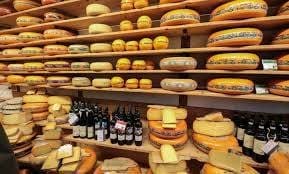
Culinary Staples. The Netherlands is famous for its cheese. Gouda, Edam, and Leyden are known worldwide, and Alkmaar is a town famous for its cheese market. Salted herring is another staple to the Dutch. Other staples include hagelslag (chocolate sprinkles), stroopwafel (caramel waffle cookies), French fries and mayonnaise, and pffertjes (small, thick pancakes)
Arts and Leisure

The Patato Eaters – Vincent van GoghArt. The Netherlands is world-renowned for its number of art and historical museums, along with its impressive collection of fine art. The most prolific period for Dutch art was the Golden Age (17th century), where the Baroque style, inherited from the Italians, became the basis for several Dutch masterpieces. The next resurgence began in the twentieth century with modern art and continues to flourish today. International art festivals occur year-round and draw big crowds from all over the world.
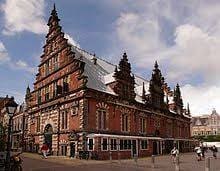
Architecture. Dutch architecture also became prominent during the Golden Age, where Baroque-style buildings were considered the norm. The end of the nineteenth century saw a resurgence of Gothic Revival architecture, and modern architecture found its place, starting in the 20th century. The vast array of buildings offers a magnificent view of varying historical styles that span centuries.
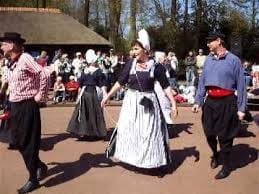
Music. Traditional Dutch music consists of simple melodies and rhymes that focus on central emotional themes like loneliness, happiness, and sadness. Today, popular culture is fixated on Nederpop (pop music), electronic/trance, and Nederhop (Dutch Hip-Hop). Classical and orchestral scores are also very popular, and Jan Sweelinck is still considered the most prolific composer in Dutch’s illustrious musical history. Other popular genres include folk, jazz, and various types of metal.
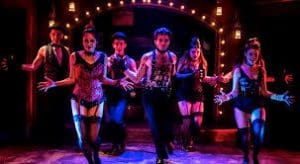
Cabaret. The Netherlands has its own unique form of cabaret that is aimed more at provoking thought on social and political themes, instead of laughter. Cabaret shows can be found in most cities and even on some television networks.
Events. The Netherlands is a hot bed for annual events in all different kinds of niches and markets, and the locals love to attend. For art there’s the Maastricht Art Show in the first half of March. The Amsterdam Roots Festival in June showcases music from the Netherlands and other parts of the world. For techno lovers, the FFWD Dance Parade is held in August. And Sinterklaas comes in December
DUTCH FABRIC
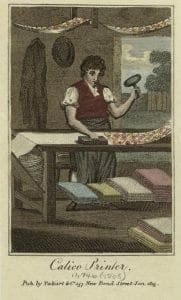
A cotton printer with a pressure woodblock in his right hand and on his left hand a glass shine on stalk. Europe around 1800
These cotton fabrics were brought to the Netherlands by the merchants of the Dutch East India Company (VOC) from the Dutch settlements on the Coromandel Coast of India. The original native patterns were adapted to suit European fashion, taste and purchaser under the supervision of the VOC. We know the end result as the cotton chintz which was used in particular in West European interiors and the clothing and costume of that period. Various parts of traditional Dutch costume were made in this chintz. A feature of the original cotton chintz is the low shine which was obtained by calendering using rice water and stone polishing. The characteristic sheen was applied to the cotton fabric not merely to given the appearance of the silken materials of the time, but of course also to resist dirt and moisture.
In the 18th century a new printing method was developed in West Europe which meant that the original chintzes could be reproduced, putting an end to imports from India. If you are wondering where the name chintz comes from, it is fairly readily explained by comparing it with the original Indian description for this sort of floral cotton material, “chitti”, meaning calico. Increasing demand in Europe led to many fabric printers being set up; in Amsterdam alone in 1750 there were some 80 printers and polishers, but by 1816 only a single printer, ‘Overtooms Welvaren’ remained, to be sold and shut down the following year. During the 19th century production was taken over by more modern mechanised printers.
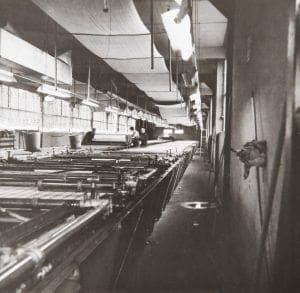
Original flat printing table at Betina – Goor. The Netherlands in 1964.
Today Betina BV printing is reproducing a number of these original hand painted and coloured floral designs as the Den Haan & Wagenmakers collection.
Wagenmakers collection.
Willem Rudolf den Haan is the creative figure responsible for the adaptations and drawings from the authentic chintz fabrics with floral patterns and palempores with trees of life, intended for interior applications and historical clothing, but particularly for patchwork and quilts. Since the ’90s the Den Haan & Wagenmakers collection has been printed by Hans ten Voorde, the owner of Betina BV printing in Goor, Netherlands. He is responsible for the hundreds of printing cylinders and the complete production process with recently also the exclusive sale to individual customers through this shop on line.
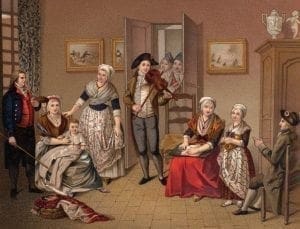
Oil paint panel by A. Maury – France. Presentation of musicians and listeners dressed in aprons of typical European printed cotton fabrics. France ca. 1800.
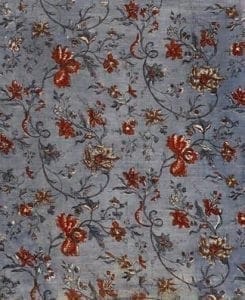

Various printed fabrics “Indiennes” and “Toile de Jouy” made in Europe. Alsace and Jouy en Josas. France late 18th century.
Fragment of a floral pattern printed and painted on cotton fabrics in chintz techniques.

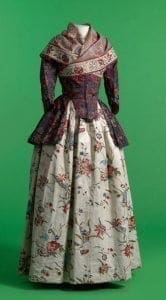
Dutch quilt made around 1860 in the province North Holland. Previously coll. DH&W, currently belonging to the Dutch Quilters Guild.
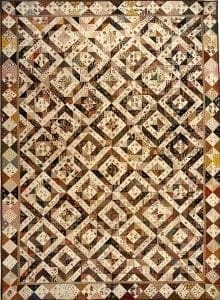
Children of Island Marken’ with on the left costume for boys up to 6 years with skirt and apron“Druivenboezel/Grapeberry”, used as inspiration for our collection tone on tone’s. The girls wear a jacket and breast piece “baaf” or “bauw” of chintz fabrics with a checkered apron.
The boy on the right image wears the antique amber necklace with a silver coin, used on Pentecost which is the most important day for traditional costumes on the Island of Marken.

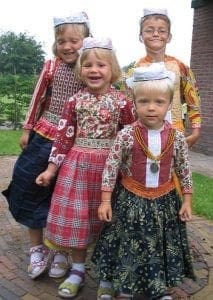
Image of dozens of young girls painting flowers on the cotton cloth/fabrics with a brush. (pinceau) The original title of the performance in French is “Les pinceauteuses”. The workshop is from Manufacture Johann Rudolf Wetter in Saint Marcel (Orange), dated 1785. The painting is part of the collection of Musée d’ Orange -Provence. France
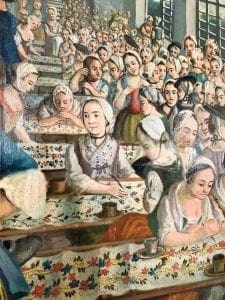
TOURISM

The Netherlands, a country in northwestern Europe, is known for a flat landscape of canals, tulip fields, windmills and cycling routes. Amsterdam, the capital, is home to the Rijksmuseum, Van Gogh Museum and the house where Jewish diarist Anne Frank hid during WWII. Canalside mansions and a trove of works from artists including Rembrandt and Vermeer remain from the city’s 17th-century “Golden Age.”
Offical website – https://www.netherlands-tourism.com/
Article curated by-Bhavika Gulrajani.
Image courtesy-Google.
